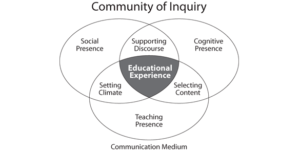This topic peaked my interested because I have spent a lot of time thinking about how to build relationships in person while in a classroom setting, however, I have not yet had a chance to think about building relationships in online learning spaces. One thing that crossed my mind before diving into the course materials was the trust that must be established in an online space. Students are given much more freedom and responsibility in online learning spaces than they are in a classroom, simply because the teacher can not watch over everyone’s shoulder at the same time. Therefore, teachers must share the importance of internet safety and privacy concerns starting at a young age. Teachers can provide students with resources and critical thinking strategies to keep themselves safe but ultimately, it is up to the students to put this into place. Teachers need to be able to trust that their students can demonstrate responsibility online at all times. I believe that this is a critical part of building strong relationships in online learning spaces because without trust, the classroom cannot be successful.
After reading some articles, listening to Dr. Barb Brown’s webinar and talking to my learning pod, I feel like I have a deeper understanding of the importance of relationships in online learning spaces, specifically for students K-12. Barb and Verena shared an article that encouraged me to reflect on the importance of classroom management. Just like classrooms in-person, classrooms online need to have guidelines and rules in order to help the teacher be successful. Although, classroom management looks very different in an online classroom it is still crucial! Martin(2019) confirms that classroom management cannot happen until the teacher-student relationship has been built, additionally Martin shares that “once the relationship was established, [teachers are] able to have meaningful conversations with the students to learn what they could do to help them and engage with them” (p. 9). As educators, we know that each student has unique needs and these needs are amplified in an online setting; therefore, we must interact with our students to learn how to support them in a way that is best for them. This connects to the shift away from the ‘typical’ learner-contact interactions that are commonly seen in online courses. In my personal experience, I have always struggled with online courses that require me to read a chapter, write an essay and hand it in without any further discussion. Therefore, I was excited to read about the Community of Inquiry (CoI) framework.

Photo retrieved from: https://coi.athabascau.ca/coi-model/coi_model_small/
I know that I still have lots of learning to do because it is a continuous journey! Here are some of the questions I hope to be able to answer by the end of the course:
How can we best support learners with designations in online settings?
What are some ideas to encourage more learner-learner instruction? (ex/ think-pair-share)
How can we teach our youngest students the importance of safe communication in order to set them up for future success?
References:
Martin, J. (2019). Building relationships and increasing engagement in the virtual classroom: Practical tools for the online instructor. Journal of Educators Online, 16(1), 1-8.Retrieved from: https://www.thejeo.com/archive/archive/2019_161/martinpdf


